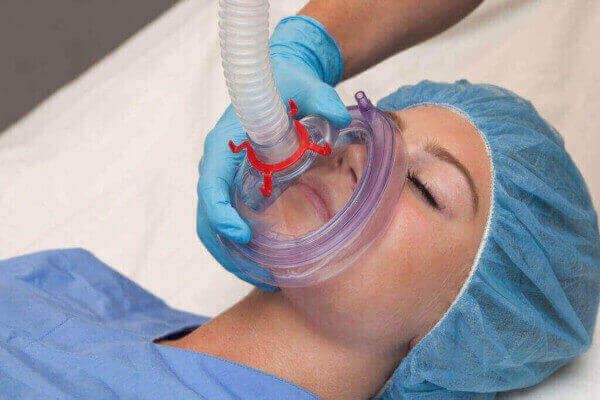Anesthesia for Carpal Tunnel Surgery
From Dr. Z - Carpal tunnel syndrome specialist
Types of Anesthesia for Carpal Tunnel Surgery
Anesthesia for carpal tunnel surgery is administered in one of two forms; either general or local (regional). General anesthesia is the most common type. That's because to treat carpal tunnel syndrome, surgeons most often perform open carpal tunnel release surgery. General anesthesia is the preferred method for this kind of operation.
But some surgeons perform endoscopic carpal tunnel release surgery. For that operation, the surgeon usually chooses a local (or regional) anesthesia. This discussion will focus on the most often used type: general anesthesia.
- FIND OUT: do you have carpal tunnel? No strings attached self-test.
Stages of general anesthesia for carpal tunnel surgery
Most people think of surgical anesthesia as having a mask placed over your face and then you fall asleep. But that's only the overall picture. The "going to sleep" part is complex. Doctors divide it into
four “stages” of surgical anesthesia.
Why are knowing the 4 stages important?
Categorizing anesthesia in these stages is useful for surgeons to better predict the course of surgical events. The stages (from I to IV) cover the range from “induction” (going to sleep) to “emergence” (waking up).
Stage I
Stage I starts with the induction of anesthesia. It ends with loss of consciousness. The patient can still feel pain in this stage. However, the actual carpal tunnel release surgery does not begin yet.
Stage II
Stage II is also the “ REM ” stage. It includes the occasional dangerous response to stimuli during carpal tunnel surgery. Usually, these are vomiting or uncontrollable movements. Doctors can shorten this stage by giving the patient a barbiturate (like sodium pentothal ) prior to administering the anesthetic agent.
Stage III
Stage III is the surgical anesthesia stage, which is the most important. It starts when the patient’s pupils constrict, with central gaze. Doctors desire this depth of surgical anesthesia. This is when muscles relax and breathing gets regular. Eye movements also stop. The goal of all anesthesia for carpal tunnel surgery is to get to this stage and maintain it. It's when the actual surgery takes place. When the surgery is finished, the doctor begins the emergence phase, bringing you back to consciousness.
Stave IV
Types of anesthesia for carpal tunnel surgery
The anesthesia doctor's (anesthetist's) main priority is to get the patient to Stage III of anesthesia quickly. Then he or she needs to keep them in that stage for carpal tunnel surgery's duration.
Doctors apply general anesthesia using inhalation anesthetics.They also go by the name “volatile” anesthetics. They are medicines which enter the body from the lungs. From there, the drug spreads through the blood and to all body tissues.
Doctors do not often use inhalation anesthetics alone. Instead, they often use them along with IV anesthetics. Doctors call a combination of inhalation and IV “balanced anesthesia”. Sometimes the IV medicine is mixed with opioids for pain relief. The IV may also include neuromuscular blockers to temporarily paralyze muscle.
Common inhalation anesthetics
- Halothane: Most carpal tunnel surgeries use this drug. It causes unconsciousness but only little pain relief. Doctors commonly administer it along with analgesic (pain relief) medicines. Halothane may be toxic to the liver. Therefore doctors must monitor liver function carefully. It has a pleasant smell and is often administered to children.
- Enflurane: This is another good anesthesia for carpal tunnel surgery. But is not as potent as halothane. It produces a quick onset of anesthesia and usually a quicker recovery. It is not for patients with kidney problems.
- Isoflurane: Unlike many other agents, isoflurane does not harm the liver. However, it may induce irregular heartbeats.
- Nitrous oxide: Doctors use this gas with other drugs like thiopental (see IV anesthetics below) to induce anesthesia. Nitrous oxide also has the quickest induction and recovery time.
In addition, it is the safest inhalation anesthetic. That’s because it doesn’t slow respiration or circulation to the brain. However, it’s a relatively weak anesthetic. Thus, it is not common as a general anesthesia for carpal tunnel surgery or most other operations.
- Sevoflurane: This drug works fast. It doesn’t irritate the airways. However, one of its metabolic products can cause kidney damage.
- Desflurane: This is a version of isoflurane. But it may irritate the airways. However, it provides a quick recovery with few adverse effects. Unfortunately, it can cause increased heart rate. Therefore, doctors won’t use it in patients with heart conditions.
Common intravenous (IV) anesthetics
Intravenous anesthetics are often used in combination with inhalation anesthesia for carpal tunnel surgery. Such "balanced anesthesia" gives the doctor better control over the anesthesia process. The most common intravenous anesthetic drugs are listed below.
- Ketamine: This drug produces different kinds of reactions compared to other IV anesthetics. It is similar to
phencyclidine , a street drug that can cause hallucinations. Ketamine often causes sensory illusions and vivid dreams during post-operative recovery. Thus, doctors do not often administer it to adults or as anesthesia for carpal tunnel surgery. However, doctors commonly use this drug for anesthetizing children. It is also commonly employed in trauma patients. It’s especially preferred for patients in shock where anesthesia equipment is not available.
- Propofol: This is common for adult use. Doctors administer it in patients in intensive care to produce unconsciousness. It helps the patient endure being in intensive care. It also helps them cooperate when using a breathing assist machine. Usually, propofol is not for children. It was also the drug which resulted in the
death of Michael Jackson .
- Etomidate: Doctors commonly use this short acting IV anesthetic. It provides general anesthesia during shorter procedures.
- Thiopental: Some medicines can produce seizures. Doctors use thiopental to control them. Also, it can lower pressure on the brain. In addition, thiopental helps treat certain mental disorders.
- Methohexital: This barbiturate derivative is short-acting. Also, it has a rapid onset of action. Its effects are similar to thiopental.






